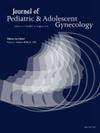Understanding Physician Practices and Preferences Using Vaginal Stents to Prevent Postoperative Vaginal Stenosis in Pediatric and Adolescent Patients
IF 1.7
4区 医学
Q3 OBSTETRICS & GYNECOLOGY
引用次数: 0
Abstract
Study Objective
The purpose of this study is to describe practices to prevent vaginal stenosis in pediatric and adolescent patients and to evaluate the strengths and weaknesses of available vaginal stents.
Methods
An online survey was distributed to North American Society for Pediatric and Adolescent Gynecology (NASPAG) members with an optional follow-up focus group. Quantitative and qualitative data were synthesized to highlight physician practices and preferences using vaginal stents, strengths and weakness of stents, and ideal stent properties.
Results
Twenty physicians completed at least 50% of the survey, and 4 participated in the focus group. Most were pediatric and adolescent gynecology specialists (95%) with fellowship training (60%) and experience in managing Müllerian anomalies (80%). Physicians reported they “always” used a vaginal stent when performing vaginoplasty for distal vaginal agenesis with a graft (62.5%) or without a graft (37.5%) and for transverse vaginal septa (57.1%). The most common type of stents used were packed condoms (60%), tracheobronchial stents (40%), Foley catheters (35%), and custom stents (35%). Participants described an ideal vaginal stent as something that would stay in place, cause little discomfort, expand, and come in a variety of lengths.
Conclusion
There are limited vaginal stent options for the pediatric and adolescent gynecology population. Participants reported variability in stents used to prevent vaginal stenosis, with commonly used vaginal stents having significant weaknesses. Future efforts are needed to identify and develop postoperative clinical guidelines to prevent vaginal stenosis.
了解医生使用阴道支架预防小儿和青少年患者术后阴道狭窄的做法和偏好。
研究目的本研究旨在描述预防儿童和青少年患者阴道狭窄的方法,并评估现有阴道支架的优缺点:方法:向北美儿童和青少年妇科协会(NASPAG)成员发放在线调查问卷,并可选择参加后续焦点小组。对定量和定性数据进行了综合,以突出医生使用阴道支架的做法和偏好、支架的优缺点以及理想支架的特性:20名医生完成了至少50%的调查,4名医生参加了焦点小组。大多数医生都是儿科和青少年妇科 (PAG) 专家(95%),接受过研究培训(60%),具有处理穆勒氏管异常的经验(80%)。医生们称,在进行阴道成形术治疗阴道远端缺失时,他们 "总是 "使用阴道支架,包括使用移植物(62.5%)或不使用移植物(37.5%),以及治疗阴道横隔(57.1%)。最常用的支架类型是包装避孕套(60%)、气管支气管支架(40%)、Foley 导管(35%)和定制支架(35%)。参与者对理想的阴道支架的描述是:能固定在阴道内、几乎没有不适感、能扩张、有各种长度:结论:PAG 患者可选择的阴道支架有限。参与者报告称,用于预防阴道狭窄的支架存在差异,常用的阴道支架存在明显缺陷。今后需要努力确定和制定预防阴道狭窄的术后临床指南。
本文章由计算机程序翻译,如有差异,请以英文原文为准。
求助全文
约1分钟内获得全文
求助全文
来源期刊
CiteScore
3.90
自引率
11.10%
发文量
251
审稿时长
57 days
期刊介绍:
Journal of Pediatric and Adolescent Gynecology includes all aspects of clinical and basic science research in pediatric and adolescent gynecology. The Journal draws on expertise from a variety of disciplines including pediatrics, obstetrics and gynecology, reproduction and gynecology, reproductive and pediatric endocrinology, genetics, and molecular biology.
The Journal of Pediatric and Adolescent Gynecology features original studies, review articles, book and literature reviews, letters to the editor, and communications in brief. It is an essential resource for the libraries of OB/GYN specialists, as well as pediatricians and primary care physicians.

 求助内容:
求助内容: 应助结果提醒方式:
应助结果提醒方式:


